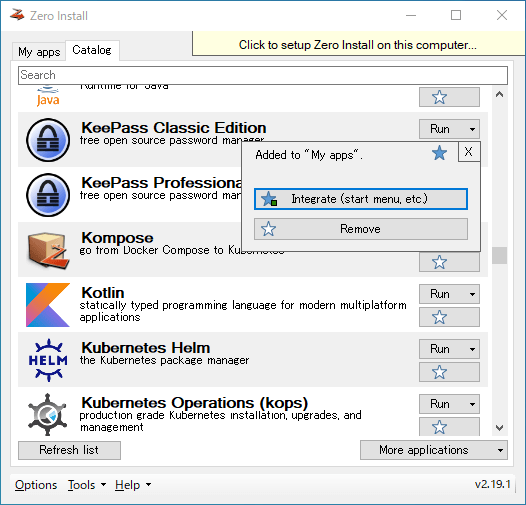

You can confirm by opening a new terminal window and running a few commands: $ # show the location of the hugo executable
#ZERO INSTALL INSTALL#
Replace brew install hugo with brew install hugo -HEAD if you want the absolute latest in-development version.īrew should have updated your path to include Hugo. The disadvantage is that you need to spend more time managing the setup, which is manageable but requires more time than the preceding two options. The advantage of building from source is that you don’t have to wait for a release to add features or bug fixes. If you don’t want to use brew, then the tarball/binary is a good choice.īuilding from Source. This gives you the flexibility to have multiple versions on your computer.

Updates are easy as well: you just repeat the process with the new binary. Downloading and installing from the tarball is also easy, although it requires a few more command line skills than does Homebrew. Package managers work well and they are easy to update.

Nevertheless, this is the recommended installation method if you want to work from a stable, widely used source. Releases may lag a few days behind because it has to be coordinated with another team. The default package will be for the most recent release, so it will not have bug fixes until the next release (i.e., unless you install it with the -HEAD option in Homebrew). Using a package manager is the simplest method and will require the least amount of work to maintain. There are pros and cons to each of the aforementioned methods: You should use the method that works best for your use case. There is no “best” way to install Hugo on your Mac.
#ZERO INSTALL MAC#
There are three ways to install Hugo on your Mac If you are familiar enough with the command line and file system, you should have no issues following along with the instructions.)
#ZERO INSTALL HOW TO#
You know how to open the macOS terminal.“MinGW” is recommended, it has been tested and built successfully.Please make sure you have installed gcc command and add it to %PATH%.If you install -tags extended version, you may encounter this error "gcc": executable file not found in %PATH%.Substitute the $HOME environment variable above with %USERPROFILE%.

If you are on macOS and using Homebrew, you can install Hugo with the following one-liner: We currently do not offer official Hugo images for Docker, but we do recommend these up to date distributions: Homebrew (macOS) usr/local/bin is the most probable location. Ideally, you should install it somewhere in your PATH for easy use. This works well for shared hosts and other systems where you don’t have a privileged account. You don’t need to install it into a global location. Once downloaded, the binary can be run from anywhere. Quick Install Binary (Cross-platform)ĭownload the appropriate version for your platform from Hugo Releases.
#ZERO INSTALL FULL#
See for the full set of supported combinations of target operating systems and compilation architectures. Hugo may also be compiled from source wherever the Go toolchain can run e.g., on other operating systems such as DragonFly BSD, OpenBSD, Plan 9, Solaris, and others.


 0 kommentar(er)
0 kommentar(er)
